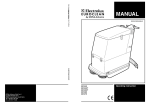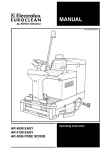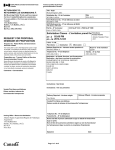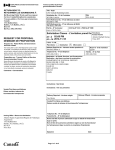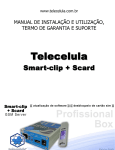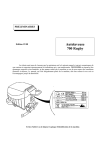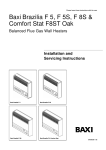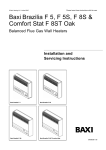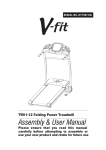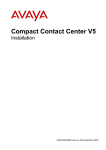Download Electrolux W 355 B/M Specifications
Transcript
graphic project VISUAL DIVISION Milano 4a 96 11-96 N I 3 4 U K E 3 1 S ELECTROLUX EUROCLEAN ITALIA SPA Località Novella Terza 20070 Guardamiglio-Italy Telephon nr. +39 377 451124 Fax nr. +39 377 51443 W 345 B/M W 355 B/M W 365 B W 375 B MANUAL FOR USE AND MAINTENANCE INDEX NOTE pag. INTRODUCTION..................................................................1 UNPACKING ......................................................................2 TECHNICAL SPECIFICATION .................................................3 MACHINE CONTROLS .........................................................4 PREPARATION FOR USE ...................................................5-9 SCRUBBING AND DRYING OPERATION ........................10-15 CHANGING BRUSHES ..................................................16-17 MAINTENANCE ...........................................................18-19 SAFETY AND FAULTS.........................................................20 TROUBLE SHOOTING ........................................................21 OPTIONALS.................................................................22-24 OPTIONALS INTRODUCTION A front splash guard is also available. INTRODUCTION This manual is a guide to the efficient use of the machine and also contains practical information concerning the functioning, adjustments and user maintenance of your new scrubber/drier. Your machine has been designed and constructed to ensure maximum performarnce and ease of operation in a wide variety of applications. Before delivery, the machine has been tested in our factory and by our distributor to ensure that it is delivered to you in perfect condition. To maintain the machine in this condition and guarantee functioning without problems, it is essential that the periodic maintenance operations indicated in this manual are properly carried out. Before using the machine, carefully read this manual and keep it within easy reach for your future reference. Indications of “LEFT” and “RIGHT” are as seen from the operators position. If you should need any further information concerning the machine, please do not hesitate to contact either Electrolux Euroclean or our local distributor. GENERAL SAFETY RULES The rules below have to be followed carefully in order to avoid damages to the operator and to the machine. - Read the labels carefully on the machine; Do not cover them for any reason and replace them immediately if damaged. - The socket for the power supply must be fitted with a standard earthing (ground) system. - With the brushes in working position, avoid touching or passing over the mains cable. Avoid damaging by squashing, bending or stressing. - Where there is damage to the mains cable, stop the machine, take off the plug from the mains system, and replace the damaged cable immediately by calling the Electrolux Service department. - Do not mix different detergents, avoiding harmful odours. - Do not place any liquid containers onto the machine. - The storage temperature has to be between +15°C and + 55°C. - The perfect operating temperature should be between 0° C and 40° C. - The humidity should be between 30 and 95%. - Do not use the machine in explosive atmosphere. - Do not use the machine as a means of transport. - Do not use acid solutions which could damage the machine. - Avoid working with the brushes when the machine stands still, in order to prevent floor damages. - Do not vacuum iflammable liquids. - In case of fire, use a powder extinguisher. Do not use water. - Do not strike shelvings or scaffoldings, where there is danger of falling objects. - Adapt the utilization speed to the adhesion conditions. - Do not exceed over the limit gradient stated, to avoid conditions of instability (2% max). - The machine has to carry out simultaneously the operations of washing and drying. Different operations have to be carried out in areas which are not permitted for the passage of non employed staff. Signal the areas of moist floors with suitable signs. - If the machine does not work properly, check by conducting simple maintenance procedures. Otherwise, it is better to ask for technical service. -Where parts are required, ask for ORIGINAL spare parts to an agent and/or to an authorized dealer. - For any maintenance operation take off the power supply from the machine. - Do not take off the pieces which require the use of tools to be removed. - Do not wash the machine with direct water jets or with high water pressure not with corrosive material. - Every 200 working hours have a machine check through a service department. - The machine should not be abandoned, because of the presence of toxic-harmful materials (batteries, oil etc.). This disposal must be subject to the rules which provide for its scrapping in appropiate centres. - The machine does not cause any harmful vibrations. MODIFICATIONS AND IMPROVEMENTS Electrolux Euroclean aim toward continuous improvement of its machines and reserves the right to carry out modifications and improvements whenever necessary without being obliged to update machines which have been sold previously. SAFETY You too can avoid accidents. No accident prevention programme is effective without the total co-operation of the person directly responsible for the functioning of the machine. The majority of accidents which may occur either during work or transferring the machine from site to site are caused by the non-observance of the most elementary safety rules. An alert and cautious operator is the best guarantee against accidents and is more effective than any other part of an accident prevention programme. The machine must be switched off and disconnected from either its battery or mains supply before any servicing or adjustment of operational parts are carried out. Ensure that any assistant is clear of the machine and that covers are closed before switching on. 24 1 UNPACKING OPTIONALS Check that you have received following parts together with the machine: Kit of cable to transform machine from mains version to battery operated version. 1- Connecting hose for squeegee Mains unit (or transformer) to change the machine from the battery operated version to the mains version. 2- Plastic bag with cables For the models W345 and W355 a kit is available to equip the machine with the membrane. 3- Squeegee In order to reduce the pressure of the machine on the floor (according to norm DIN 18032) two rear twin wheels can be mounted. 4- Documents 2 W345 and W355 W365 and W375 cod. D00.06630 cod. D00.06640 23 OPTIONALS TECHNICAL SPECIFICATION In addition to the normal accessories supplied with the machine the following optionals are available: Batteries: - For models 345/355 two 12 V batteries 140 amp hours. - For models 365/375 four 6V batteries 240 amp hours. Battery chargers: - For models 345/355/365/375 two different battery chargers are available with different specifications according to the country where there will be used: a) 24 Volts 30 A 50 Hz b) 24 Volts 30 A 60 Hz Different types of brushes and pad holders are available. For a complete list consult your nearest dealer. W345 430mm (17 “) 1 required Union mix scrub brush cod.145 00 42-00 Polypropylene scrub brush cod.145 00 96-00 Silicon Carbide scrub brush cod.140 00 63-00 Pad holder cod.145 00 43-00 W355 280mm (11 “) 2 required Union mix scrub brush cod.145 Polypropylene scrub brush cod.145 Silicon Carbide scrub brush cod.145 Pad holder cod.145 W365 320mm (12,5 “) 2 required Union mix scrub brush cod.145 Polypropylene scrub brush cod.145 Silicon Carbide scrub brush cod.140 Pad holder cod.145 W375 370mm (14,5 “) 2 required Union mix scrub brush cod.145 Polypropylene scrub brush cod.145 Silicon Carbide scrub brush cod.140 Pad holder cod.145 22 00 00 00 00 01 01 01 01 45-00 97-00 64-00 46-00 02-00 00-00 03-00 04-00 TECHNICAL SPECIFICATION MODELS W345B/M W355B/M W365B Working width (mm) 430 538 628 728 Width of squeegee (mm) 700 800 920 1010 N° of brushes Brush/s diameter (mm) 07-00 05-00 08-00 09-00 1 2 2 2 430 280 320 370 Brush speed (rpm) 180 270 270 180 Brush motor (watts) 1x250 2x200 2x200 2x375 30-45 Brush pressure (Kg) 13-27 20-31 21-36 Clean liquid tank (ltr) 34/50 (*) 38/54 (*) 72 72 Recovery tank (ltr) 35/51 (*) 39/55 (*) 74 74 Vacuum motor type 2 stages. 3 stages. 3 stages. 3 stages. 420 540 540 540 1150 1700 1700 1700 yes Vacuum motor (watts) Vacuum depression (mm/H2O) Run time hour meter yes yes yes Battery condition indicator yes yes yes yes Traction motor (watts) 120 120 200 200 Forward speed (Km/H) 0-4,5 0-4,5 0-5 0-5 Reverse speed (Km/H) 0-2,5 0-2,5 0-2,5 0-2,5 Drive wheel diameter (mm) 150 150 200 200 Castor wheel diameter (mm) 80 80 100 100 Operating voltage (volts) 24 24 24 24 1235 1235 1330 1330 Length (mm) Width (mm) 460 580 685 775 Height (mm) 1050 1050 1095 1095 Weight without batteries (kg) 97 112 125 135 Weight with mains unit (kg) 132 146 n/a n/a 2 x12v 2 x12v 4 x 6v 4 x 6v Standard wet batteries Capacity 20 at hr rate (Ah) Charger - taper current 01 01 01 01 W375B Low maintenance dry batteries 140 140 240 240 12 cells 25 A 12 cells 25 A 12 cells 25 A 12 cells 25 A 4 x 6v 2 x 12v 2 x 12v 4 x 6v Capacity 5 at hr rate (Ah) 70 70 160 160 Charger - constant voltage 24v. 25 A 24v. 25 A 24v. 25 A 24v. 25 A (*) with the membrane (optional) 3 MACHINE CONTROLS 1 2 3 TROUBLE SHOOTING 4 PROBLEM Nothing works. POSSIBLE CAUSE No power. CHECK Is the battery plugged in. Is the mains lead plugged in and switched on. Is the mains socket live. 5 6 7 1- Scrubbing detergent flow adjustment push button 2- Suction on/off push button 3- Brush motor on/off push button 4- Run-time hour meter 5- Scrubbing detergent flow boost pump on/off push button 6- Recovery tank full warning indicator 7- Brush release push button 8- Battery condition voltmeter 9- Master key-switch 10- Drive function control 11- Switch for the speed selection 12- Scrubbing detergent tank emptying hose 13- Handle height adjustment locking handwheel 14- Drive motor on/off switch 15- Squeegee control lever 16- Recovery tank emptying hose 17- Squeegee 18- Brush pressure control hand-wheel 19- Squeegee pressure control 20- Squeegee rake angle control 21- Brush lift/lower pedal 4 8 10 11 12 13 14 15 16 17 18 19 20 21 9 Is the tank empty. Fill the tank. Are the brushes revolving and the machine moving as well as the flow control activated. Try this sequence. Is the tank filter blocked. Remove and clean. Are the solenoid valves blocked. Remove and clean. Are the pipes blocked. Flush through with clean hot water. Blockage in hose. Remove and flush through with water. Worn sgueegee not sitting fully on floor. Adjust pressure and rake. Torn tank lid gasket. Replace All indicators flashing when key switched on. Traction control not in neutral position. Centre the traction control then switch the key on. All 3 indicators of the battery condition meter flashing. Traction drive electronics faulty. Call Service Engineer. or Replace P.C.B. 3 indicators of battery condition meter flashing in sequence Overload in electrical circuit. Will reset when cooled down. Check motor currents for overload, or tight bearings etc. No liquid supply to the brushes. Squeegee is not drying the floor well. 21 SAFETY AND FAULTS Keyswitch/accelerator sequence: This safety feature prevents the machine from moving if the machine is accidentally switched on with either forward or reverse function engaged (due to machine fault or an operator error). When this happens the leds on display panel begin flashing. PREPARATION FOR USE Partially unscrew the two middle levers on the squeegee. Push the squeegee into the locating lugs as illustrated and fully tighten the levers. (pull the lever up to disingage it and make its rotation free). Mosfet short circuit: This safety feature prevents the machine from moving if the machine is switched on with the the part of the electronic print card controlling drive power is in short circuit (in this case the machine would move immediately at full speed). This condition is signalled by the 3 voltmeter leds which start flashing. Overheating of the electronic print card cooling vents: This protection device of the electronic print card prevents damage to the card itself during prolonged use of the machine when one of its functions is overloaded. In this condition the machine automatically cuts off all its functions which are then only restored when temperature returns to normal value. This condition is signalled by the lighting up in sequence of the 3 voltmeter leds. Micro switch: Micro switch to shut off all the functions when the tank is in the upright position. (SEMKO APPROVAL) 20 Push the coiled end of the squeegee hose fully home onto the tubular spigot in the centre of the squeegee. Push the straight end of the squeegee hose onto the tank inlet pipe which protrudes through a slot in the lower rear panel. 5 PREPARATION FOR USE MAINTENANCE The three solenoid valve bodies may be removed by turning them through 45 degrees and lifting them away to reveal the plunger and seating of each valve. These should be cleaned of scale and of any other foreign matter. For models working with batteries follow instructions below, whereas in the case of mains operated models the transformer has already been placed inside the machine and needs no further installation. The batteries are supplied without liquid, therefore they must be filled up with the appropriate acid before they can be used. Take special care when handling the acid as it is corrosive, If it should come into contact with skin or eyes, wash abundantly with water and consult a doctor. The W345B & W355B machines use two 12 volt batteries, the W365B & W375B machines use four 6 volt batteries. Study the illustrations then fit the batteries and connect the links supplied as indicated. Plug the battery socket into the machine as shown. Fold over the flaps to cover the battery tops, then lower the tank unit to safely cover exposed working parts. + Regularly inspect the squeegee for damage or wear to the lips. The lips may be easily replaced by unscrewing the retaining strips, remove the lips, replace with new, then screw the cover strips back again to retain them. + - 6 Important:periodically clean the suction filters; this is very important not to reduce the suction capability of the squeegee. 19 MAINTENANCE PREPARATION FOR USE BEFORE ANY MAINTENANCE IS CARRIED OUT THE BATTERY MUST BE UNPLUGGED OR THE MAINS LEAD UNPLUGGED. 345-355 Periodically unscrew the filter inside the scrubbing detergent tank, scrub whit a stiff brush under running water to remove any accumulated foreign matter. Note: for the models 345-355 it is enough to pull the filter to remove it. Press the filter to mount it. The machine may now be run for trial purposes but before putting it into service the batteries should be charged to bring them up to their maximum capacity. New batteries will gradually “run in” and increase in capacity to a maximum in about the first 10 charge/discharge cycles. + + 365-375 For the battery operated models, the level of the liquid inside batteries must be checked periodically, and topped up with distilled water if necessary. Raise the bonnet, uncover the battery compartment, remove caps and check level. Special care should be taken when handling battery liquid as it is corrosive. If it should come into contact with skin or eyes, wash abundantly with water and consult a doctor. Recharge batteries when necessary with an appropriate battery charger. 18 - - + - + If necessary the batteries should be charged using an appropriate battery charger. Remove the battery caps during the charging operation. Check that the Hertz and Voltage readings of the mains supply correspond to those of the battery charger. 7 PREPARATION FOR USE Drop the brushes (one or two depending on the model) roughly side by side in front of the machine, the actual position does not matter. Switch the machine on by turning the key in the key-switch a quarter turn clockwise. Wait momentarily until the battery condition indicator above the switch lights. Note: The mains machine will have to be plugged in, the indicator then only shows that power is available. Drive the machine forward by holding the handgrips, then rolling the thumb wheels forward until the machine moves completely over the brushes. To stop release the thumb wheels and they will return to a neutral position. This will ensure the brushes are fully located under the drive plates. 8 CHANGING BRUSHES Position the new brushes roughly side by side on the floor in front of the machine. Move the machine forward until the brushes are pushed along the floor. Release the brush lift/ lower pedal and allow it to settle at its highest point. Rock the machine forward and back about 50mm (2”) to settle the drive plates into the brush centers. Press the brush motor on/off push button to engage the brushes. Press the brush pedal down and latch it into its lower position, press the brush push button again to stop the motors. The machine is now ready for use again. 17 CHANGING BRUSHES To replace brushes carry out the following sequence of operations: The machine should be switched on but all functions switched off. PREPARATION FOR USE Lower the brush unit by pushing the pedal to the right to unlatch it. Then allow it to rise as far as it will go. Push the machine forward then back about 50mm (2”) to ensure the drive has located in the brushes. Raise the brush unit by pressing down the brush lift/lower pedal and latching in its lowest position. Press the brush release push button momentarily and the brushes at present fitted will be unloaded from the machine. Move the machine backward by rolling the traction control rearward until the brushes are visible in front of the machine. Press the brush “on/off” push button: the indicator will light and the brush motors will engage the brushes. Once the brushes have locked on, raise the brush unit by pushing the pedal down and latching it at its lower position. Press the brush “on/off” push button again (see previous picture); the green indicator will wait for the motors to spin down to stop before going out. Note: The motors do not stop immediately. The brushes are now loaded onto the machine. 16 9 SCRUBBING AND DRYING OPERATION Open the tank lid. SCRUBBING AND DRYING OPERATION Unclip the recovery tank emptying hose and remove the drain plug whilst holding the pipe at its highest extent, then lower it carefully into a gully or drain. Note: It is against Water Regulations to discharge detergents into a surface drain, only use a foul gully or drain. Fill the left tank with water to within about 75mm (3”) from the top edge then add the scrubbing detergent in a quantity to make a dilution according to its instruction. Too strong a mix wastes detergent, too weak a mix will not work efficiently. The machine is now ready for use so move off to the site to be cleaned. At the same time as emptying the recovery tank check if the clean tank requires refilling. If the clean liquid runs out then it is recommended that to save time the recovery tank be emptied at the same time as the clean tank is refilled. OFF Switch the machine on by turning the key in the key-switch a quarter turn clockwise. 10 A switch is fitted on the rear panel to the right of the control handle which controls the drive motor power. With the switch lever in the up position the traction motor is disconnected and the machine may be pushed easily from site to site when the mains lead is unplugged or when the batteries are not available. ON 15 SCRUBBING AND DRYING OPERATION Push the machine slowly forward, and adjust the squeegee pressure control until the lips bend over evenly as illustrated below. Then re-adjust the rake control to make the radius of the squeegee sit parallel to the floor and the lips bend evenly. SCRUBBING AND DRYING OPERATION Press the brush “on/off” push button: the indicator will light and the brush motors will start. TRAVEL DIRECTION FLOOR LEVEL The lips must be replaced when they become feather edged or torn. Fully lift the squeegee control lever (just below and to the right of the machine handle) to lower the squeegee to a flat floor surface. Lower the brush unit by pushing the pedal to the right to unlatch it. If the recovery tank full indicator lights continuosly for a period of 6 seconds the suction motor will switch off and the tank will have to be emptied before continuing the operation. Note: Lift the brushes whilst still moving forward then stop traction, in that order, to avoid “polo rings”. Lift the squeegee and stop the suction motor. Drive the machine to an emptying point or use a transfer trolly to empty the recovery tank. 14 Drive the machine forward by holding the handgrips. And turning the thumb wheels. 11 SCRUBBING AND DRYING OPERATION When the machine is ready for scrubbing select the estimated amount of clean liquid required by pressing the detergent flow control on/off push button; an indicator will light which can be increased in three steps for varying the quantity of liquid delivered to the brushes. SCRUBBING AND DRYING OPERATION Press the suction on/off push button. Start the brushes rotating, move the machine slowly forward, then immediately lower the brushes to the floor by lifting the foot pedal. (If the brushes are allowed to rotate in contact with the floor without the machine moving then it is likely to cause “polo rings” on the floor). Whilst moving forward observe the cleaning effect on the floor and adjust the detergent flow to the minimum required whilst being liquid enough to be picked up by the squeegee. This allows the liquid to last longer before having to refill the tank. If too little liquid is used the floor will dry with a “sludgy” grey look to it. If more liquid is required press the boost pump on/off push button which will double the amount of flow; this will be shown by the indicator. Note: The liquid will be delivered to the brushes only when the machine is moving forward and the brushes are rotating. If either the brushes or the forward traction are stopped the liquid flow will stop. The height of the drive handle can be adjusted by turning the knob A. A B The speed range can be selected by means of switch B. + Lower the squeegee to the floor. 12 Adjust the brush pressure to the minimum required; this will assist in using the least amount of power necessary from the battery which will then last longer before requiring recharge. 13














